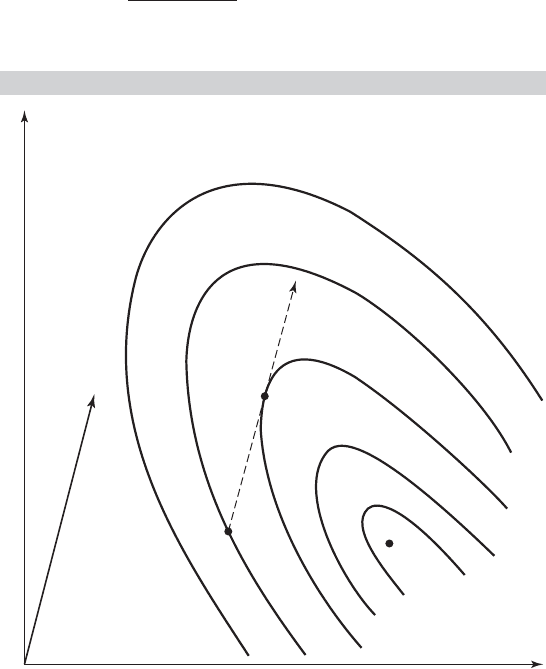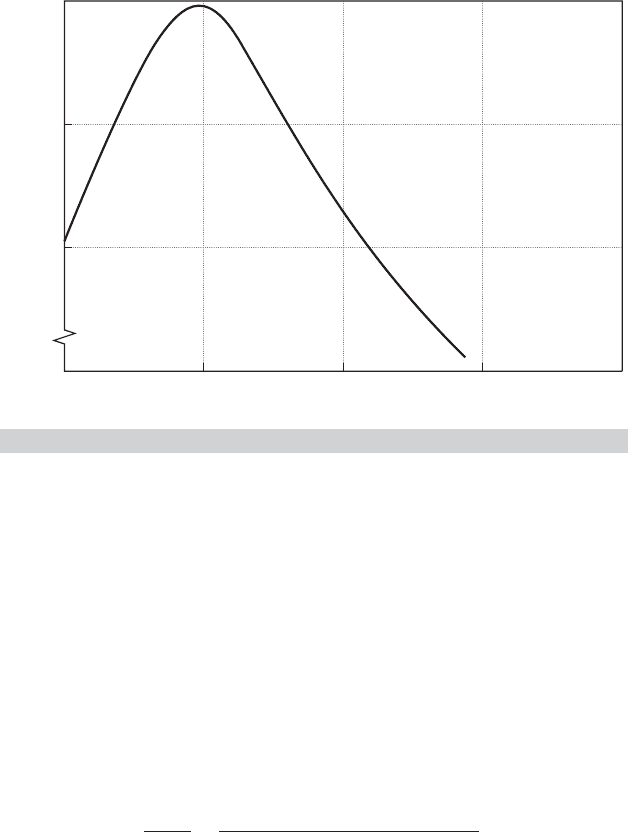Greene W.H. Econometric Analysis
Подождите немного. Документ загружается.


APPENDIX E
✦
Computation and Optimization
1089
DEFINITION D.15
Order less than n
δ
A sequence c
n
, is of order less than n
δ
, denoted o(n
δ
), if and only if plim(1/n
δ
)c
n
equals
zero.
Thus, in our examples, γ
2
n
is O(n
−1
), Var[x
(1),n
]isO(n
−2
) and o(n
−1
), S
n
is O(n
2
)(δ equals +2in
this case), ln L(θ ) is O(n)(δ equals +1), and c
n
is O(1)(δ = 0). Important particular cases that we
will encounter repeatedly in our work are sequences for which δ =1or−1.
The notion of order of a sequence is often of interest in econometrics in the context of the
variance of an estimator. Thus, we see in Section D.3 that an important element of our strategy for
forming an asymptotic distribution is that the variance of the limiting distribution of
√
n( ¯x
n
−μ)/σ
is O(1). In Example D.10 the variance of m
2
is the sum of three terms that are O(n
−1
), O(n
−2
),
and O(n
−3
). The sum is O(n
−1
), because n Var[m
2
] converges to μ
4
− σ
4
, the numerator of the
first, or leading term, whereas the second and third terms converge to zero. This term is also the
dominant term of the sequence. Finally, consider the two divergent examples in the preceding list.
S
n
is simply a deterministic function of n that explodes. However, ln L(θ) = n ln θ − θ
i
x
i
is the
sum of a constant that is O(n) and a random variable with variance equal to n/θ. The random
variable “diverges” in the sense that its variance grows without bound as n increases.
APPENDIX E
Q
COMPUTATION AND
OPTIMIZATION
E.1 INTRODUCTION
The computation of empirical estimates by econometricians involves using digital computers
and software written either by the researchers themselves or by others.
1
It is also a surprisingly
balanced mix of art and science. It is important for software users to be aware of how results
are obtained, not only to understand routine computations, but also to be able to explain the
occasional strange and contradictory results that do arise. This appendix will describe some of the
basic elements of computing and a number of tools that are used by econometricians.
2
Section E.2
1
It is one of the interesting aspects of the development of econometric methodology that the adoption of
certain classes of techniques has proceeded in discrete jumps with the development of software. Noteworthy
examples include the appearance, both around 1970, of G. K. Joreskog’s LISREL [Joreskog and Sorbom
(1981)] program, which spawned a still-growing industry in linear structural modeling, and TSP [Hall (1982)],
which was among the first computer programs to accept symbolic representations of econometric models and
which provided a significant advance in econometric practice with its LSQ procedure for systems of equations.
An extensive survey of the evolution of econometric software is given in Renfro (2007).
2
This discussion is not intended to teach the reader how to write computer programs. For those who expect
to do so, there are whole libraries of useful sources. Three very useful works are Kennedy and Gentle (1980),
Abramovitz and Stegun (1971), and especially Press et al. (1986). The third of these provides a wealth of
expertly written programs and a large amount of information about how to do computation efficiently and
accurately. A recent survey of many areas of computation is Judd (1998).

1090
PART VI
✦
Appendices
then describes some techniques for computing certain integrals and derivatives that are recurrent
in econometric applications. Section E.3 presents methods of optimization of functions. Some
examples are given in Section E.4.
E.2 COMPUTATION IN ECONOMETRICS
This section will discuss some methods of computing integrals that appear frequently in econo-
metrics.
E.2.1 COMPUTING INTEGRALS
One advantage of computers is their ability rapidly to compute approximations to complex func-
tions such as logs and exponents. The basic functions, such as these, trigonometric functions, and
so forth, are standard parts of the libraries of programs that accompany all scientific computing
installations.
3
But one of the very common applications that often requires some high-level cre-
ativity by econometricians is the evaluation of integrals that do not have simple closed forms and
that do not typically exist in “system libraries.” We will consider several of these in this section.
We will not go into detail on the nuts and bolts of how to compute integrals with a computer;
rather, we will turn directly to the most common applications in econometrics.
E.2.2 THE STANDARD NORMAL CUMULATIVE
DISTRIBUTION FUNCTION
The standard normal cumulative distribution function (cdf) is ubiquitous in econometric models.
Yet this most homely of applications must be computed by approximation. There are a number
of ways to do so.
4
Recall that what we desire is
(x) =
'
x
−∞
φ(t) dt, where φ(t) =
1
√
2π
e
−t
2
/2
.
One way to proceed is to use a Taylor series:
(x) ≈
M
i=0
1
i!
d
i
(x
0
)
dx
i
0
(x − x
0
)
i
.
The normal cdf has some advantages for this approach. First, the derivatives are simple and not
integrals. Second, the function is analytic; as M −→ ∞ , the approximation converges to the true
value. Third, the derivatives have a simple form; they are the Hermite polynomials and they can
be computed by a simple recursion. The 0th term in the preceding expansion is (x) evaluated
at the expansion point. The first derivative of the cdf is the pdf, so the terms from 2 onward are
the derivatives of φ(x), once again evaluated at x
0
. The derivatives of the standard normal pdf
obey the recursion
φ
i
/φ(x) =−xφ
i−1
/φ(x) − (i − 1)φ
i−2
/φ(x),
where φ
i
is d
i
φ(x)/dx
i
. The zero and one terms in the sequence are one and −x. The next term
is x
2
− 1, followed by 3x − x
3
and x
4
− 6x
2
+ 3, and so on. The approximation can be made
3
Of course, at some level, these must have been programmed as approximations by someone.
4
Many system libraries provide a related function, the error function, erf(x) = (2/
√
π)
&
x
0
e
−t
2
dt. If this is
available, then the normal cdf can be obtained from (x) =
1
2
+
1
2
erf(x/
√
2), x ≥0 and (x) =1−(−x), x ≤0.

APPENDIX E
✦
Computation and Optimization
1091
2.00
0.20
0.00
0.20
0.40
0.60
0.80
1.00
1.20
1.50 1.00 0.50 0.00
x
0.50 1.00 1.50 2.00
F
FA
FIGURE E.1
Approximation to Normal cdf.
more accurate by adding terms. Consider using a fifth-order Taylor series approximation around
the point x =0, where (0) =0.5 and φ(0) =0.3989423. Evaluating the derivatives at zero and
assembling the terms produces the approximation
(x) ≈
1
2
+ 0.3989423[x − x
3
/6 + x
5
/40].
[Some of the terms (every other one, in fact) will conveniently drop out.] Figure E.1 shows the
actual values (F ) and approximate values (FA) over the range −2 to 2. The figure shows two
important points. First, the approximation is remarkably good over most of the range. Second, as
is usually true for Taylor series approximations, the quality of the approximation deteriorates as
one gets far from the expansion point.
Unfortunately, it is the tail areas of the standard normal distribution that are usually of
interest, so the preceding is likely to be problematic. An alternative approach that is used much
more often is a polynomial approximation reported by Abramovitz and Stegun (1971, p. 932):
(−|x|) = φ(x)
5
i=1
a
i
t
i
+ ε(x), where t = 1/[1 + a
0
|x|].
(The complement is taken if x is positive.) The error of approximation is less than ±7.5 × 10
−8
for all x. (Note that the error exceeds the function value at |x| > 5.7, so this is the operational
limit of this approximation.)
E.2.3 THE GAMMA AND RELATED FUNCTIONS
The standard normal cdf is probably the most common application of numerical integration of a
function in econometrics. Another very common application is the class of gamma functions. For

1092
PART VI
✦
Appendices
positive constant P, the gamma function is
(P) =
'
∞
0
t
P−1
e
−t
dt.
The gamma function obeys the recursion (P) = (P − 1)( P − 1), so for integer values of
P,(P) =(P −1)! This result suggests that the gamma function can be viewed as a generalization
of the factorial function for noninteger values. Another convenient value is (
1
2
) =
√
π.By
making a change of variable, it can be shown that for positive constants a, c, and P,
'
∞
0
t
P−1
e
−at
c
dt =
'
∞
0
t
−(P+1)
e
−a/t
c
dt =
1
c
a
−P/c
P
c
. (E-1)
As a generalization of the factorial function, the gamma function will usually overflow for
the sorts of values of P that normally appear in applications. The log of the function should
normally be used instead. The function ln (P) can be approximated remarkably accurately with
only a handful of terms and is very easy to program. A number of approximations appear in the
literature; they are generally modifications of Stirling’s approximation to the factorial function
P! ≈ (2π P)
1/2
P
P
e
−P
,so
ln (P) ≈ (P − 0.5)ln P − P + 0.5ln(2π) + C + ε(P),
where C is the correction term [see, e.g., Abramovitz and Stegun (1971, p. 257), Press et al. (1986,
p. 157), or Rao (1973, p. 59)] and ε(P) is the approximation error.
5
The derivatives of the gamma function are
d
r
(P)
dP
r
=
'
∞
0
(ln t)
r
t
P−1
e
−t
dt.
The first two derivatives of ln (P) are denoted (P) =
/ and
(P) = (
−
2
)/
2
and
are known as the digamma and trigamma functions.
6
The beta function, denoted β(a, b),
β(a, b) =
'
1
0
t
a−1
(1 −t)
b−1
dt =
(a)(b)
(a + b)
,
is related.
E.2.4 APPROXIMATING INTEGRALS BY QUADRATURE
The digamma and trigamma functions, and the gamma function for noninteger values of P and
values that are not integers plus
1
2
, do not exist in closed form and must be approximated. Most
other applications will also involve integrals for which no simple computing function exists. The
simplest approach to approximating
F(x) =
'
U(x)
L(x)
f (t) dt
5
For example, one widely used formula is C = z
−1
/12 − z
−3
/360 − z
−5
/1260 + z
−7
/1680 − q, where z = P
and q = 0ifP > 18, or z = P + J and q = ln[P( P + 1)(P + 2) ···(P + J − 1)], where J = 18 − INT(P),if
not. Note, in the approximation, we write (P) = (P!)/P + a correction.
6
Tables of specific values for the gamma, digamma, and trigamma functions appear in Abramovitz and Stegun
(1971). Most contemporary econometric programs have built-in functions for these common integrals, so the
tables are not generally needed.

APPENDIX E
✦
Computation and Optimization
1093
is likely to be a variant of Simpson’s rule, or the trapezoid rule. For example, one approximation
[see Press et al. (1986, p. 108)] is
F(x) ≈
1
3
f
1
+
4
3
f
2
+
2
3
f
3
+
4
3
f
4
+···+
2
3
f
N−2
+
4
3
f
N−1
+
1
3
f
N
,
where f
j
is the function evaluated at N equally spaced points in [L, U] including the endpoints
and = (L −U)/(N −1). There are a number of problems with this method, most notably that
it is difficult to obtain satisfactory accuracy with a moderate number of points.
Gaussian quadrature is a popular method of computing integrals. The general approach is
to use an approximation of the form
'
U
L
W(x) f (x) dx ≈
M
j=1
w
j
f (a
j
),
where W(x) is viewed as a “weighting” function for integrating f (x), w
j
is the quadrature weight,
and a
j
is the quadrature abscissa. Different weights and abscissas have been derived for several
weighting functions. Two weighting functions common in econometrics are
W(x) = x
c
e
−x
, x ∈ [0, ∞),
for which the computation is called Gauss–Laguerre quadrature, and
W(x) = e
−x
2
, x ∈ (−∞, ∞),
for which the computation is called Gauss–Hermite quadrature. The theory for deriving weights
and abscissas is given in Press et al. (1986, pp. 121–125). Tables of weights and abscissas for many
values of M are given by Abramovitz and Stegun (1971). Applications of the technique appear
in Chapters 14 and 17.
E.3 OPTIMIZATION
Nonlinear optimization (e.g., maximizing log-likelihood functions) is an intriguing practical prob-
lem. Theory provides few hard and fast rules, and there are relatively few cases in which it is
obvious how to proceed. This section introduces some of the terminology and underlying theory
of nonlinear optimization.
7
We begin with a general discussion on how to search for a solution
to a nonlinear optimization problem and describe some specific commonly used methods. We
then consider some practical problems that arise in optimization. An example is given in the final
section.
Consider maximizing the quadratic function
F(θ) = a + b
θ −
1
2
θ
Cθ,
where C is a positive definite matrix. The first-order condition for a maximum is
∂ F(θ)
∂θ
= b − Cθ = 0. (E-2)
This set of linear equations has the unique solution
θ = C
−1
b. (E-3)
7
There are numerous excellent references that offer a more complete exposition. Among these are Quandt
(1983), Bazaraa and Shetty (1979), Fletcher (1980), and Judd (1998).

1094
PART VI
✦
Appendices
This is a linear optimization problem. Note that it has a closed-form solution; for any a, b, and C,
the solution can be computed directly.
8
In the more typical situation,
∂ F(θ)
∂θ
= 0 (E-4)
is a set of nonlinear equations that cannot be solved explicitly for θ.
9
The techniques considered
in this section provide systematic means of searching for a solution.
We now consider the general problem of maximizing a function of several variables:
maximize
θ
F(θ), (E-5)
where F(θ) may be a log-likelihood or some other function. Minimization of F(θ) is handled by
maximizing −F(θ). Two special cases are
F(θ) =
n
i=1
f
i
(θ), (E-6)
which is typical for maximum likelihood problems, and the least squares problem,
10
f
i
(θ) =−(y
i
− f (x
i
, θ))
2
. (E-7)
We treated the nonlinear least squares problem in detail in Chapter 7. An obvious way to search
for the θ that maximizes F(θ) is by trial and error. If θ has only a single element and it is known
approximately where the optimum will be found, then a grid search will be a feasible strategy. An
example is a common time-series problem in which a one-dimensional search for a correlation
coefficient is made in the interval (−1, 1). The grid search can proceed in the obvious fashion—
that is, ...,−0.1, 0, 0.1, 0.2,...,then
ˆ
θ
max
−0.1to
ˆ
θ
max
+0.1 in increments of 0.01, and so on—until
the desired precision is achieved.
11
If θ contains more than one parameter, then a grid search
is likely to be extremely costly, particularly if little is known about the parameter vector at the
outset. Nonetheless, relatively efficient methods have been devised. Quandt (1983) and Fletcher
(1980) contain further details.
There are also systematic, derivative-free methods of searching for a function optimum that
resemble in some respects the algorithms that we will examine in the next section. The downhill
simplex (and other simplex) methods
12
have been found to be very fast and effective for some
problems. A recent entry in the econometrics literature is the method of simulated annealing.
13
These derivative-free methods, particularly the latter, are often very effective in problems with
many variables in the objective function, but they usually require far more function evaluations
than the methods based on derivatives that are considered below. Because the problems typically
analyzed in econometrics involve relatively few parameters but often quite complex functions
involving large numbers of terms in a summation, on balance, the gradient methods are usually
going to be preferable.
14
8
Notice that the constant a is irrelevant to the solution. Many maximum likelihood problems are presented
with the preface “neglecting an irrelevant constant.” For example, the log-likelihood for the normal linear
regression model contains a term—(n/2) ln(2π)—that can be discarded.
9
See, for example, the normal equations for the nonlinear least squares estimators of Chapter 7.
10
Least squares is, of course, a minimization problem. The negative of the criterion is used to maintain
consistency with the general formulation.
11
There are more efficient methods of carrying out a one-dimensional search, for example, the golden section
method. See Press et al. (1986, Chap. 10).
12
See Nelder and Mead (1965) and Press et al. (1986).
13
See Goffe, Ferrier, and Rodgers (1994) and Press et al. (1986, pp. 326–334).
14
Goffe, Ferrier, and Rodgers (1994) did find that the method of simulated annealing was quite adept at
finding the best among multiple solutions. This problem is common for derivative-based methods, because
they usually have no method of distinguishing between a local optimum and a global one.

APPENDIX E
✦
Computation and Optimization
1095
E.3.1 ALGORITHMS
A more effective means of solving most nonlinear maximization problems is by an iterative
algorithm:
Beginning from initial value θ
0
, at entry to iteration t,ifθ
t
is not the optimal value for
θ, compute direction vector
t
, step size λ
t
, then
θ
t+1
= θ
t
+ λ
t
t
. (E-8)
Figure E.2 illustrates the structure of an iteration for a hypothetical function of two variables.
The direction vector
t
is shown in the figure with θ
t
. The dashed line is the set of points θ
t
+
λ
t
t
. Different values of λ
t
lead to different contours; for this θ
t
and
t
, the best value of λ
t
is
about 0.5.
Notice in Figure E.2 that for a given direction vector
t
and current parameter vector θ
t
,
a secondary optimization is required to find the best λ
t
. Translating from Figure E.2, we obtain
the form of this problem as shown in Figure E.3. This subsidiary search is called a line search, as
we search along the line θ
t
+ λ
t
t
for the optimal value of F(.). The formal solution to the line
search problem would be the λ
t
that satisfies
∂ F(θ
t
+ λ
t
t
)
∂λ
t
= g(θ
t
+ λ
t
t
)
t
= 0, (E-9)
FIGURE E.2
Iteration.
1.8
1.9
2.0
2.1
2.2
2.3
2
t
t
1

1096
PART VI
✦
Appendices
0
1.9
1.95
2.0
0.5
F(
t
t
t
)
1 1.5
t
2
FIGURE E.3
Line Search.
where g is the vector of partial derivatives of F(.) evaluated at θ
t
+λ
t
t
. In general, this problem
will also be a nonlinear one. In most cases, adding a formal search for λ
t
will be too expensive,
as well as unnecessary. Some approximate or ad hoc method will usually be chosen. It is worth
emphasizing that finding the λ
t
that maximizes F (θ
t
+λ
t
t
) at a given iteration does not generally
lead to the overall solution in that iteration. This situation is clear in Figure E.3, where the optimal
value of λ
t
leads to F(.) = 2.0, at which point we reenter the iteration.
E.3.2 COMPUTING DERIVATIVES
For certain functions, the programming of derivatives may be quite difficult. Numeric approx-
imations can be used, although it should be borne in mind that analytic derivatives obtained
by formally differentiating the functions involved are to be preferred. First derivatives can be
approximated by using
∂ F(θ)
∂θ
i
≈
F(···θ
i
+ ε ···) − F(···θ
i
− ε ···)
2ε
.
The choice of ε is a remaining problem. Extensive discussion may be found in Quandt (1983).
There are three drawbacks to this means of computing derivatives compared with using
the analytic derivatives. A possible major consideration is that it may substantially increase the
amount of computation needed to obtain a function and its gradient. In particular, K +1 function
evaluations (the criterion and K derivatives) are replaced with 2K + 1 functions. The latter may
be more burdensome than the former, depending on the complexity of the partial derivatives
compared with the function itself. The comparison will depend on the application. But in most
settings, careful programming that avoids superfluous or redundant calculation can make the
advantage of the analytic derivatives substantial. Second, the choice of ε can be problematic. If
it is chosen too large, then the approximation will be inaccurate. If it is chosen too small, then
there may be insufficient variation in the function to produce a good estimate of the derivative.

APPENDIX E
✦
Computation and Optimization
1097
A compromise that is likely to be effective is to compute ε
i
separately for each parameter, as in
ε
i
= Max[α|θ
i
|,γ]
[see Goldfeld and Quandt (1971)]. The values α and γ should be relatively small, such as 10
−5
.
Third, although numeric derivatives computed in this fashion are likely to be reasonably accurate,
in a sum of a large number of terms, say, several thousand, enough approximation error can accu-
mulate to cause the numerical derivatives to differ significantly from their analytic counterparts.
Second derivatives can also be computed numerically. In addition to the preceding problems,
however, it is generally not possible to ensure negative definiteness of a Hessian computed in
this manner. Unless the choice of ε is made extremely carefully, an indefinite matrix is a possi-
bility. In general, the use of numeric derivatives should be avoided if the analytic derivatives are
available.
E.3.3 GRADIENT METHODS
The most commonly used algorithms are gradient methods, in which
t
= W
t
g
t
, (E-10)
where W
t
is a positive definite matrix and g
t
is the gradient of F(θ
t
):
g
t
= g(θ
t
) =
∂ F(θ
t
)
∂θ
t
. (E-11)
These methods are motivated partly by the following. Consider a linear Taylor series approxima-
tion to F(θ
t
+ λ
t
t
) around λ
t
= 0:
F(θ
t
+ λ
t
t
) F(θ
t
) + λ
t
g(θ
t
)
t
. (E-12)
Let F(θ
t
+ λ
t
t
) equal F
t+1
. Then,
F
t+1
− F
t
λ
t
g
t
t
.
If
t
= W
t
g
t
, then
F
t+1
− F
t
λ
t
g
t
W
t
g
t
.
If g
t
is not 0 and λ
t
is small enough, then F
t+1
− F
t
must be positive. Thus, if F(θ) is not already
at its maximum, then we can always find a step size such that a gradient-type iteration will lead
to an increase in the function. (Recall that W
t
is assumed to be positive definite.)
In the following, we will omit the iteration index t, except where it is necessary to distinguish
one vector from another. The following are some commonly used algorithms.
15
Steepest Ascent The simplest algorithm to employ is the steepest ascent method, which uses
W = I so that = g. (E-13)
As its name implies, the direction is the one of greatest increase of F (.). Another virtue is that
the line search has a straightforward solution; at least near the maximum, the optimal λ is
λ =
−g
g
g
Hg
, (E-14)
15
A more extensive catalog may be found in Judge et al. (1985, Appendix B). Those mentioned here are some
of the more commonly used ones and are chosen primarily because they illustrate many of the important
aspects of nonlinear optimization.

1098
PART VI
✦
Appendices
where
H =
∂
2
F(θ)
∂θ ∂θ
.
Therefore, the steepest ascent iteration is
θ
t+1
= θ
t
−
g
t
g
t
g
t
H
t
g
t
g
t
. (E-15)
Computation of the second derivatives matrix may be extremely burdensome. Also, if H
t
is not
negative definite, which is likely if θ
t
is far from the maximum, the iteration may diverge. A
systematic line search can bypass this problem. This algorithm usually converges very slowly,
however, so other techniques are usually used.
Newton’s Method The template for most gradient methods in common use is Newton’s
method. The basis for Newton’s method is a linear Taylor series approximation. Expanding the
first-order conditions,
∂ F(θ)
∂θ
= 0,
equation by equation, in a linear Taylor series around an arbitrary θ
0
yields
∂ F(θ)
∂θ
g
0
+ H
0
(θ − θ
0
) = 0, (E-16)
where the superscript indicates that the term is evaluated at θ
0
. Solving for θ and then equating
θ to θ
t+1
and θ
0
to θ
t
, we obtain the iteration
θ
t+1
= θ
t
− H
−1
t
g
t
. (E-17)
Thus, for Newton’s method,
W =−H
−1
, =−H
−1
g,λ= 1. (E-18)
Newton’s method will converge very rapidly in many problems. If the function is quadratic, then
this method will reach the optimum in one iteration from any starting point. If the criterion
function is globally concave, as it is in a number of problems that we shall examine in this text,
then it is probably the best algorithm available. This method is very well suited to maximum
likelihood estimation.
Alternatives to Newton’s Method Newton’s method is very effective in some settings, but it
can perform very poorly in others. If the function is not approximately quadratic or if the current
estimate is very far from the maximum, then it can cause wide swings in the estimates and even
fail to converge at all. A number of algorithms have been devised to improve upon Newton’s
method. An obvious one is to include a line search at each iteration rather than use λ = 1. Two
problems remain, however. At points distant from the optimum, the second derivatives matrix
may not be negative definite, and, in any event, the computational burden of computing H may be
excessive.
The quadratic hill-climbing method proposed by Goldfeld, Quandt, and Trotter (1966) deals
directly with the first of these problems. In any iteration, if H is not negative definite, then it is
replaced with
H
α
= H −αI, (E-19)
